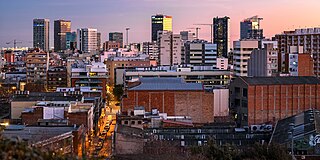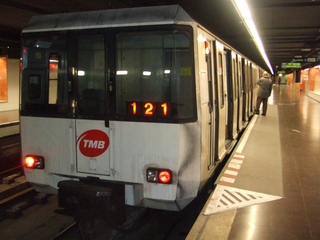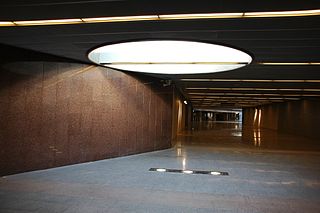
L'Hospitalet de Llobregat, often shortened to L'Hospitalet or just L'H, is a municipality in the Barcelonès comarca, in Catalonia (Spain). It is part of the Barcelona metropolitan area, the Barcelona province, and of the Barcelona conurbation.

The Trambaix is one of Barcelona's three tram systems. It is operated by TRAMMET connecting the Baix Llobregat area with the city of Barcelona, Catalonia, Spain. It opened to the public on 5 April 2004 after a weekend when the tram could be used free of charge.

Line 1, shortened to L1, coloured red and often simply called Línia vermella, is the second oldest Barcelona Metro line, after line L3. It is the longest line of the Barcelona Metro, and links L'Hospitalet de Llobregat and Santa Coloma de Gramenet. Originally operated by the independent Ferrocarril Metropolitano Transversal de Barcelona, it is today operated by Transports Metropolitans de Barcelona (TMB) and is part of the ATM fare-integrated main transport system. L1 is the only metro line in Spain to use Iberian gauge tracks, as used by most Spanish main line railways.

Hospital de Bellvitge, formerly known as Feixa Llarga, is a Barcelona Metro station, in the L'Hospitalet de Llobregat municipality of the Barcelona metropolitan area, and named after the nearby Bellvitge University Hospital. The station is the western terminus of line L1.

Gornal is a railway station on the Llobregat–Anoia Line. It is located in the neighborhood of the same name, in the L'Hospitalet de Llobregat municipality, to the south-west of Barcelona, in Catalonia, Spain. It was opened in 1987, when the line's section between Ildefons Cerdà and Sant Josep stations was put underground. It is served by Barcelona Metro line 8, Baix Llobregat Metro lines S33, S4 and S8, and commuter rail lines R5, R6, R50 and R60.

Europa | Fira is a railway and metro station on the Llobregat–Anoia Line. It is located underneath Gran Via de les Corts Catalanes, near Plaça d'Europa and Carrer d'Amadeu Torner, in the L'Hospitalet de Llobregat municipality, to the south-west of Barcelona, in Catalonia, Spain. Opened on 13 May 2007, it was due to be named Amadeu Torner, in reference to the street of the same name. The station can be accessed from both sidewalks of Gran Via, serving as a major public transport access to the Gran Via business center. It is served by Line 8, Line 9, Baix Llobregat Metro lines S33, S4 and S8, and commuter rail lines R5, R6, R50 and R60.

Bellvitge–Rambla Marina is a Barcelona Metro station, in the L'Hospitalet de Llobregat municipality of the Barcelona metropolitan area, and named after the nearby neighbourhood of Bellvitge. The station is served by line L1. It is some 750 metres (2,460 ft) west of Bellvitge railway station, served by Rodalies de Catalunya commuter and regional rail services.

Avinguda Carrilet, also known as L'Hospitalet Avinguda Carrilet, is an interchange complex underneath Avinguda Carrilet in the L'Hospitalet de Llobregat municipality, to the south-west of Barcelona, in Catalonia, Spain. It consists of a railway station on the Llobregat–Anoia Line and a Barcelona Metro line 1 (L1) station. The Llobregat–Anoia Line station is served by Barcelona Metro line 8 (L8), Baix Llobregat Metro lines S33, S4 and S8, and commuter rail lines R5, R6, R50 and R60. The services on the Llobregat–Anoia Line are operated by Ferrocarrils de la Generalitat de Catalunya (FGC), whilst the L1 is operated by Transports Metropolitans de Barcelona (TMB).

Bellvitge is a mostly working-class neighborhood in L'Hospitalet de Llobregat, belonging to the metropolitan area of Barcelona. It is part of L'Hospitalet's District VI, along with Gornal.

Rambla Just Oliveras is a Barcelona Metro station, in the L'Hospitalet de Llobregat municipality of the Barcelona metropolitan area, and named after the nearby street of Rambla Just Oliveras. The station is served by line L1, and is adjacent to the L'Hospitalet de Llobregat railway station, the main Rodalies Barcelona and mid-distance transport hub in the area.

Rail transport in Catalonia operates on three rail gauges and services are operated by a variety of public operators:

The Llobregat–Anoia Line is an unconnected metre gauge railway line linking Barcelona with the Baix Llobregat, Bages and Anoia regions, in Catalonia, Spain. Its name refers to the fact that it follows the course of the Llobregat and Anoia rivers for most of its length. Plaça d'Espanya station serves as the Barcelona terminus of the line, then continuing northwards to Martorell, where two main branches to Manresa and Igualada are formed. It also includes several freight branches, accounting for a total line length of 138 kilometres (86 mi) and 41 passenger stations.

Plaça d'Europa is a square in the District VII of L'Hospitalet de Llobregat suburb of Barcelona, Catalonia in Spain. Located on the Granvia de l'Hospitalet avenue at the intersection with Carrer d'Amadeu Torner. It is part of L'Hospitalet's recent urban development, and one of its biggest squares at 33 ha, with a distinguishable skyline made up of high-rises, among the tallest structures in the city, some of which are designed by the renowned architect Toyo Ito. It is expected to become its economic centre, and will allow different parts of the city formerly severed by the Granvia to become interconnected. It is still not completed but already featuring most of its planned buildings and infrastructure. Part of Fira de Barcelona, near it stand the pavilions of rest of Fira de Barcelona and the shopping centre Gran Via 2.

Public transport in Cornellà de Llobregat is an important part of the transportation network spanning the Metropolitan Area of Barcelona. The city of Cornellà, a mostly working-class area with strong dormitory town traits, is one of the most populated in the Baix Llobregat with about 90,000 inhabitants and a daily destination for thousands of commuters in the urban area of the capital.

Public transport in Castelldefels belongs to the broader Metropolitan Area of Barcelona transportation network, organised around the entity Autoritat del Transport Metropolità (ATM). Castelldefels is both a dormitory town, with many commuters driving everyday into Barcelona, and an important locality in itself.

Gran Via is the second major business district of Barcelona, after Diagonal Mar. It forms part of the Fira de Barcelona, the second largest trade fair and exhibition centre in Europe. It straddles the borders between Barcelona, L'Hospitalet de Llobregat and El Prat de Llobregat. The Gran Via business centre consists of the following subdivisions: Gran Via, which has 240,000 m2 of exhibition floor space divided into 8 pavilions; the Gran Via Convention Centre, with capacity for 5,600 delegates and a surface area of 14,000 m2; the more than ten skyscrapers alongside Plaza de Europa; also Gran Vía 2 near Barcelona International Airport, which has a shopping centre with 200 shops, 20 restaurants, 15 cinemas and a hypermarket. Gran Via is also adjacent to Ciutat de la Justícia de Barcelona i l'Hospitalet de Llobregat which hosts most of the legal departments of the Barcelona metropolitan area.

Granvia l'Hospitalet or Granvia l'H is a district in the municipality of L'Hospitalet de Llobregat, a south-western suburb of the Barcelona metropolitan area.

The Estadi Municipal de Futbol de L'Hospitalet is a football stadium located in the Feixa Llarga district of L'Hospitalet de Llobregat, Catalonia, Spain. It was opened in 1999. It has a capacity of 6740 seated spectators. Currently it is the home of football club CE L'Hospitalet. The stadium is some 700 metres (2,300 ft) from the Hospital de Bellvitge metro station, on line L1 of the Barcelona Metro.

Bellvitge is a Rodalies de Catalunya commuter rail station serving the neighborhood of the same name, in the L'Hospitalet de Llobregat municipality, to the south-west of Barcelona, in Catalonia, Spain. It is on the conventional Madrid–Barcelona railway, between El Prat de Llobregat and Barcelona Sants, and is served by all trains on Barcelona commuter rail service lines R2 and R2 Nord, as well as some R2 Sud trains. Some trains on regional line R15 also call at the station.


















